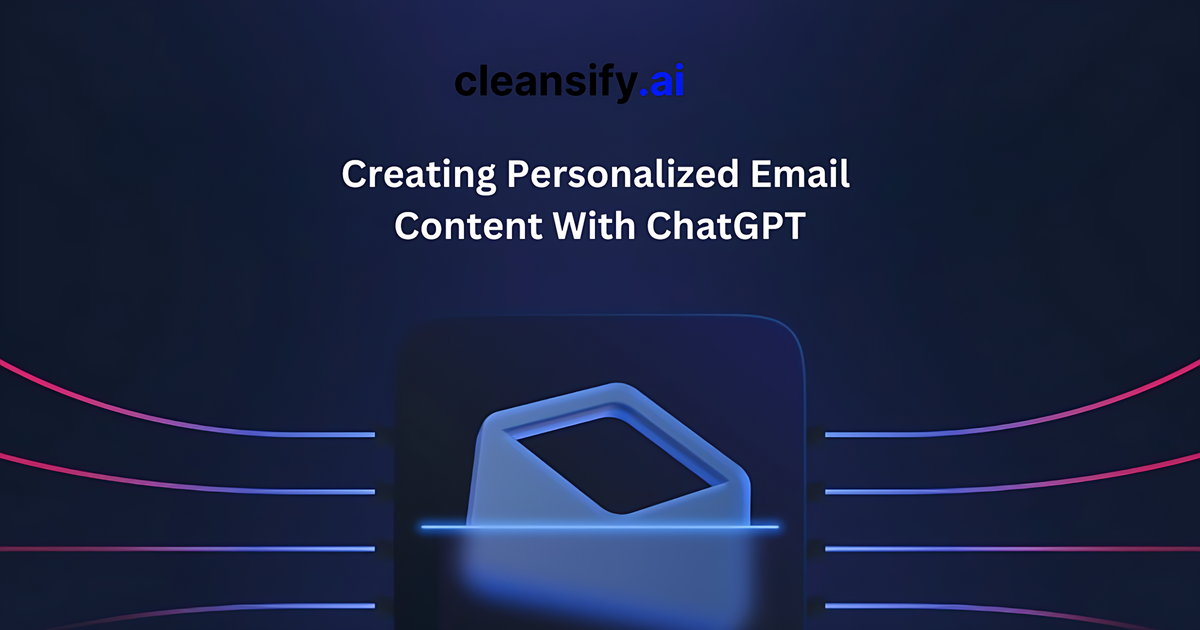Creating Personalized Email Content With ChatGPT

In the field of marketing, particularly email marketing, artificial intelligence is essential. Many email marketers believe it will provide their email campaigns the much-needed boost for improved results because of its affordability and direct approach. Read our article to find out how ChatGPT can help you personalize your email content.
How to create personalized email content with ChatGPT?
Creating personalized email content with ChatGPT can be a powerful way to increase engagement with your audience. Here is a step-by-step guide on how to get started:
- First, you will need to train your own version of ChatGPT on your chosen dataset. This dataset should ideally contain a large number of examples of the type of content that you want to generate, such as previous emails that you have sent to your audience.
- Once your model is trained, you can use it to generate personalized email content by providing a prompt that includes information about the recipient, such as their name, interests, and other relevant details.
- To create the prompt, you can use a template with placeholders for the recipient's information. For example, you might use the following template: "Dear [Name], I hope this email finds you well. I noticed that you are interested in [Interest], and I wanted to share some content related to that topic."
- Once you have the prompt, you can feed it into the model and generate a personalized email. You can also fine-tune your model by providing it with more examples of personalized email content and iterating the process.
- Once the generated email is suitable for the audience you want to address, and before sending, it is important to proofread and double-check the text.
- To personalize the emails even further, you can use data like the recipient’s past interactions with your business, and personal information like location, company, job title, etc. to create more personalized and specific content, by using this data while generating the prompt.
- Finally, you can use personalized email content to increase engagement with your audience by sending targeted and relevant messages that resonate with them.
How can AI help in personalizing email content?
AI can help personalize email content in several ways, including:
- Personalized subject lines: Using natural language processing (NLP) techniques, AI models can analyze past email data to generate personalized subject lines more likely to catch the recipient's attention.
- Personalized body content: AI can analyze the recipient's past interactions, such as which links they clicked or which products they viewed, to personalize the body content of the email.
- Dynamic content: AI can be used to generate dynamic content that changes depending on the recipient's past interactions, location, or other factors.
- Real-time personalization: AI-powered systems can analyze a recipient's behavior and preferences in real time, allowing emails to be sent with up-to-date and relevant content.
- Automated A/B testing: AI can help in identifying which subject lines, body content, or other elements are most effective for different segments of recipients and optimizing the email campaigns accordingly.
Why is personalized email content essential for you?
The personalized email content is important for businesses because it helps to increase engagement with their audience. When emails are tailored to the specific interests and preferences of the recipient, they are more likely to be opened and read. This, in turn, leads to increased click-through rates, conversions, and ultimately, revenue.
Personalized email content also helps to build trust and strengthen relationships with customers. By demonstrating that you understand their needs and interests, you can create a sense of loyalty and deepen their connection to your brand. Additionally, when customers feel that your emails are relevant to them, they are less likely to unsubscribe or mark them as spam, which helps to maintain a healthy email list.
Personalization also enables you to segment your email list and send different content to different groups based on their behavior and preferences. This way, you can make sure that the right message is reaching the right person, and that its timing is appropriate.
Another benefit of personalized email content is the ability to increase personalization as the customer journey progresses. By collecting data on the recipient's past interactions with your business, you can personalize future emails even more. For example, you might use purchase history to recommend products, or web browsing behavior to send personalized offers.
Personalized email content helps to increase engagement, and build trust, and revenue, by providing customers with relevant and targeted content. It also allows you to segment your audience and create a more targeted and timed approach. It also enables businesses to improve their personalization as the customer journey progresses. All this help to deliver a better customer experience and retain customers.
Conclusion
It is important to note that while ChatGPT can be a powerful tool for creating personalized email content, it is not a substitute for human creativity and judgment. The generated text should be proofread and carefully reviewed before sending, to ensure that it is accurate, appropriate, and engaging for your audience. Overall, Personalized emails are more likely to be opened and read, and by using ChatGPT to create this content, it is easy to scale and automate the process, allowing you to reach more customers with less effort.